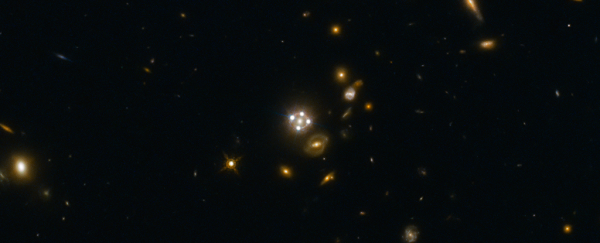By measuring the way light bends around distant galaxies, a group of astronomers have verified earlier findings that our Universe is not only getting bigger, but expanding at a rate much faster than previously thought.
The only problem is, these new calculations don't match the estimates made by previous observations, which suggests that either something is wrong in our measurements, or we're now looking at the effects of new physics beyond the Standard Model.
We've known for nearly a century that the Universe is getting bigger - ever since Belgian astronomer Georges Lemaître figured the stretching of light waves from distant galaxies meant space was expanding away from us in all directions.
Yet nine decades on, we're still not exactly sure what causes space to inflate the way it does. And it looks like this expansion is speeding up.
Work done by Nobel Laureate Brian Schmidt with Nicholas B. Suntzeff in the 1990s contributed to a model that suggests the expansion of the Universe isn't slowing down, but accelerating.
The lingering question now is: Exactly how fast is the Universe's expansion speeding up?
This rate of increased expansion is described by the Hubble constant.
"The Hubble constant is crucial for modern astronomy as it can help to confirm or refute whether our picture of the Universe - composed of dark energy, dark matter and normal matter - is actually correct, or if we are missing something fundamental," said lead researcher Sherry Suyu from the Max Planck Institute for Astrophysics in Germany.
But there's a problem with the Hubble constant - physicists can't quite agree on a number.
A 2016 study based on data from the Hubble Space Telescope last year produced one of the most accurate estimates of the Hubble constant to date, but it disagreed by observations made by the Planck telescope, which measures the Universe's cosmic background radiation.
This means our current physics couldn't explain how the Universe could be expanding as fast as the Hubble telescope had indicated.
Without a way to line these numbers up, physicists weren't confident that they truly understood how the Universe works.
At the time of the Hubble discovery last year, Noble laureate Adam Riess explained: "You start at two ends, and you expect to meet in the middle if all of your drawings are right and your measurements are right. But now the ends are not quite meeting in the middle and we want to know why."
To try to figure out once and for all what's going on, Suyu and her colleagues have used a slightly different technique to measure the Hubble constant.
Rather than measuring the light directly, a group of astronomers from the wonderfully named H0LiCOW collaboration (which stands for H0 Lenses in COSMOGRAIL's Wellspring) have used the way light bends around the gravity wells of five distant galaxies to measure how rapidly they're expanding away from us.
The galaxies were chosen for their positions between us and more distant quasars - super bright regions of space at the heart of other galaxies.
Thanks to the way gravity warps space like a metaphorical bowling ball on a mattress, the light from the quasars was bent in a curve around the gravity-dense galaxies, in a phenomenon called gravitational lensing.
Given that galaxies aren't perfectly round, this presented astronomers with multiple images of each distant quasar.
Each image was a snapshot of light, which took a slightly different path around the galaxy. So as the brightness of the quasar shifted, astronomers could use the multiple images to calculate the Hubble constant - how rapidly the galaxies were moving away from us.
"Our method is the most simple and direct way to measure the Hubble constant as it only uses geometry and General Relativity, no other assumptions," explains one of the team, Frédéric Courbin from Ecole Polytechnique Fédérale de Lausanne in Switzerland.
Using these new observations, the team was able to update the Hubble constant estimate to 71.9 ± 2.7 kilometres per second per megaparsec (44.6 ± 1.7 miles per second per megaparsec). One megaparsec is around 3.3 million light-years.
This estimate is very similar to the Hubble telescope estimate made last year. And thanks to the new precise measurements, the team was able to calculate that this figure was accurate to 3.8 percent.
But despite how confident the figure is, it still doesn't match up with the number predicted by the Planck telescope, which looks at the radiation left over from the Big Bang.
That data suggests the rate of expansion is slower - last year, the Planck telescope estimate for the Hubble constant was 67.8 ± 0.9 kilometres per second per megaparsec (42.1± 0.5 miles per second per megaparsec).
So now that further results have confirmed this gap in the two numbers, what does that mean?
It could be one of several things - the assumptions made while calculating the Planck's Hubble constant could be wrong. Or we might simply be seeing a statistical fluctuation.
Or, more intriguingly, the discrepancy could be the result of brand new physics that we're yet to uncover, which affect the way the Universe is growing.
"The expansion rate of the Universe is now starting to be measured in different ways with such high precision that actual discrepancies may possibly point towards new physics beyond our current knowledge of the Universe," said Suyu.
The team now plans to shrink the margin for error by carrying out the same measurements on up to 100 quasars, to see if their Hubble constant remains consistent.
"If you still see something when the error bars shrink, maybe it's new physics, beyond the Standard Model of cosmology," said team member Chris Fassnacht from the University of California, Davis.
This research will be published in a series of papers in the Monthly Notices of the Royal Astronomical Society this week. But you can read the papers online now here, here, and here.
